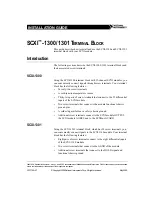
4-20
Workstation 4 and 4 LX Field Service Guide
WS4 LX Technical Overview
Point of Sale Interfaces
Pole/Rear LCD Customer Display
Just prior to a customer display update, the API sends the MSR an XOFF
command to place it in standby mode. This is done by setting
MSR_OE#
low at
U25-1, while placing the XOFF command on the
TXD2
line at U25-2. While in
the standby mode, the reader is capable of buffering a single card swipe data. U28
is a TTL to RS232 level converter required by the RS232 based MSR.
To remove the MSR from the COM port, the API sets
MSR_IE#
high at U30-13 to
isolate
MSR_RX
from
RXD2
at U30-11. The transmit line to the MSR is disabled
by setting
MSR_OE#
high at U46-1, disabling
MSR_TX
at U25-3. The MSR is
now disconnected.
The API switches the interface baud rate from 9600 to 115K baud. The Pole/Rear
Customer Display interfaces are enabled by setting
POLE_OE#
low at U30-1 to
pass serial data appearing on
TXD2
to
POLE_TX
at U30-3.
POLE_TX
drives a
pair of OR gates in U18 that buffer the transmit line to CN2-2 for the Pole LCD
Customer Display and J1-2 for the Rear LCD Customer Display.
The customer display port can selectively receive serial data from the Rear or Pole
LCD Customer Display as required.
To receive data from a Rear LCD Customer Display, the API sets
REAR_IE#
low
at U30-10, placing data from the rear display at U30-9 on
RXD2
at U30-8, where
it is fed to the UART in U36.
To receive data from a Pole LCD Customer Display, the API sets
POLE_IE#
low
at U30-1, gating
POLE_RX
at U30-5 on to the
RXD2
line at U30-6.
After the display update, the API switches the interface speed from 115K to 9600
baud, re-connects the MSR and sends an XON command. If a card swipe occurred
during the display update cycle, the MSR forwards the card data it buffered to the
Super IO.
Rear LCD Customer Display Firmware Programming
Referring to Figure 4-8, note the addition of two pins to J1, the Rear Display
connector.
The LCD Customer Display, (Rear or Pole Mount) contains a micro controller
with on-board flash EEPROM for firmware storage. The firmware can be
reprogrammed to support new features or to correct program bugs.
















































